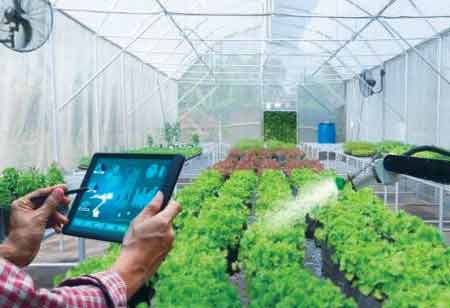Thank you for Subscribing to Agri Business Review Weekly Brief
Exploring the Future of Automated Farming
Automated farming combines technology and sustainability to enhance efficiency, productivity and environmental health.

By
Agri Business Review | Wednesday, October 09, 2024
Stay ahead of the industry with exclusive feature stories on the top companies, expert insights and the latest news delivered straight to your inbox. Subscribe today.
Automated farming combines technology and sustainability to enhance efficiency, productivity and environmental health. Integrating AI, robotics, and data analytics optimises resource use, increases crop yields, and ensures long-term agricultural resilience.
FREMONT CA: The future of automated farming stands at the intersection of technology and sustainability, poised to transform the agricultural landscape. As the global population continues to rise and environmental challenges intensify, the integration of automation in farming practices emerges as a crucial solution for enhancing efficiency, productivity and sustainability.
Technological innovations such as drones, robotic harvesters and artificial intelligence-driven data analytics are transforming traditional farming methods. They enable farmers to optimise resource usage, reduce labour costs and increase crop yields. Automated systems facilitate precise monitoring of soil health and crop conditions, paving the way for more informed decision-making and sustainable practices.
Planning the First Automated Farm Project
Strategic decisions are essential when embarking on an automated farming project, especially regarding the selection of an appropriate location and the choice of crops or livestock. These decisions should consider market demand and sustainability principles, ensuring that automation supports environmental health. After identifying the venue, careful budgeting and timeline planning will guide the integration of advanced technology into traditional farming methods, helping align financial resources and operational goals for a successful transition into automation.
Selecting the Location and Crops for Automation
When choosing the ideal location for an automated farm, factors such as climate, soil quality and pest prevalence must be assessed. The suitability of different areas for specific crops, such as vegetable farming, will largely depend on the soil's fertility and environmental conditions. Vertical farming can maximise efficiency for urban or space-constrained settings by optimising space and resource use. Automation systems, including computer-controlled irrigation and pest management, align crop production with market demands.
Developing the Budget and Timeline
A comprehensive budget for an automated farm project extends beyond equipment costs, factoring in long-term benefits such as improved biodiversity through precision agriculture. Budgeting must include technologies like soil sensors for moisture optimisation and robotics for efficient tasks like milking or harvesting. Timelines should accommodate the gradual integration of these technologies, ensuring that each step positively impacts agricultural productivity without unnecessary delays.
Selecting Automation Technologies
The selection of automation technologies, including robots and sensors, is pivotal for efficient farm operations. Various agricultural robots are available, each suited to different tasks such as planting, harvesting, or monitoring soil conditions. By integrating these mechanical aids, farmers can meet food industry standards while reducing operational risks. In addition to robots, environmental sensors collect real-time data, enabling informed decision-making that promotes sustainability and aligns with broader agricultural goals.
Comparing Robots and Sensors
Agricultural robots and sensors bring precision to farming, particularly in complex environments like vineyards. Robots capable of navigating uneven terrain conduct tasks from soil analysis to grape harvesting, all backed by data analytics to optimise production outcomes. Such technological advances enhance efficiency and enable more accurate farming practices.
Implementing Farm Management Software
Farm management software has become increasingly critical, especially in regions with specific challenges like water scarcity. Advanced software solutions integrate real-time field monitoring, resource allocation and operational management. Tools such as those help optimise irrigation and reduce water waste, improving profitability despite environmental uncertainties.
Automation in Agricultural Practices
Implementing automated systems in agriculture introduces a new level of control over farm processes. This includes planning the farm layout for specific crops, integrating robotics for essential tasks and optimising seed placement through algorithms. Maintaining the machinery, such as regular servicing of a combine harvester, is necessary to ensure operational continuity. Properly maintaining these systems helps maximise yields and sustain long-term agricultural productivity.
These advancements help address pressing challenges such as labour shortages, environmental sustainability and the growing global demand for food. As farmers integrate these systems, they will improve operational efficiency and contribute to long-term agricultural resilience and food security. The transition to automation is essential for meeting future demands while preserving the health of the ecosystems, ensuring that farming remains innovative and sustainable.





